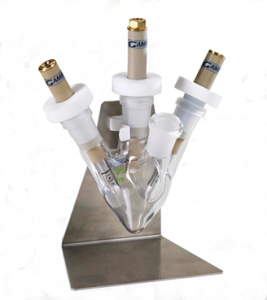Summary and action points for Working Group 2
Danish Battery Society, Annual Meeting 7. April 2016
Daniel Sørensen held a short presentation about the use of impedance spectroscopy to obtain values related to conductivity properties in electrode materials. Steen and Eivind mentioned that the impedance measured was very dependent on the geometry of the electrode, and the size and shape of the particles. This led to a discussion regarding the bulk resistance (ideally in single crystals) versus the resistance typically measured in whole battery cells. Daniel presented two cases about the measurement of the bulk electronic and ionic conductivities, and techniques to separate them.
See the presentation by following the link below:
Presentations from the working groups
(https://drive.google.com/folderview?id=0B1XEeNNxnSyOcVU1Z1dEU2JqTms&usp=sharing)
A short discussion then emerged where the student participants presented problems they had encountered during their own impedance measurements, followed by suggestions for improvements by the more experienced participants in the working group. It was generally agreed among the students that a seminar in impedance spectroscopy would be very beneficial. Two or three speakers could be invited with special emphasis on application to batteries. Eivind suggested Torben Jacobsen from DTU Risø as the expert in EIS theory. Other suggested speakers were Johan Hjelm, DTU Risø, and Andre Weber, KIT. Daniel suggested SDU as the place for the seminar, due to its central location.
It was suggested to make round-robin measurements where special samples from a research group could be distributed to other groups for similar measurements in order to confirm the validity of the research group’s measurements. At the moment this need doesn’t seem to be present. On the other hand, Jonathan Højberg suggested that it could be beneficial to ensure that all research groups are able to extract the same results from a particular sample. Haldor Topsøe could provide a batch of LNMO to serve as the reference sample, as they specialize in producing very uniform electrode powders. The recipe used by Haldor Topsøe to make electrode coatings is available at Danish Battery Society’s webpage. After each group has produced a coating and made an impedance spectrum, the results will be compared and discussed. This idea was well received as everyone is interested in ensuring that they are able to make accurate measurements. The details of the measurements will be posted on the webpage.
Action points:
EIS seminar
Daniel will contact the suggested speakers in order to arrange an EIS seminar.
EIS standard measurements
Daniel will arrange the details of the measurement setup with Jonathan Højberg. When ready, further information will be posted on the webpage, and the relevant participants will be contacted by mail.
Purpose of the group
In this work group, we will discuss topics related to the conduction of charge in electrode materials and how we improve and measure ionic and electronic conductivities. The discussion could be separated into three main areas:
- What is the optimal way to measure conductivity properties of electrode materials in terms of technique, cell type, electrode setup and dimension, etc.? It is expected that impedance spectroscopy will be the main technique used for measurement of conduction properties, but the participants should feel free to include other techniques (e.g. GITT).
- What is the best way to interpret conductivity data? How can varying experimental conditions help the interpretation?
- How can conductivity data help to construct a strategy to improve the conductivity of electrode materials?
Electrochemical Impedance Spectroscopy (EIS) is a powerful tool for the investigation of conduction phenomena, as it is able to separate the individual processes in the conduction chain on the frequency scale. The experimental setup is crucial in obtaining parameters that most precisely reflect the sample properties, and many aspects must be considered in order to obtain high-quality data. Impedance spectra can also be difficult to interpret, for example due to similar time constants of the involved processes, and a large degree of interpretation is involved when choosing the proper equivalent circuit to fit one’s data to. A useful strategy in this regard is to vary the experiment conditions, or sample dimension of composition, in a systematic way and hope that these changes give rise to systematic differences in the obtained impedance spectra. Finally, it is useful, from the outset; to consider how one’s measurements fit into an overall strategy to improve the conductivity of the electrode material. All these aspects are open for discussion in this work group.
Members (6)
Key person: Daniel Risskov Sørensen, SDU
Mette Filsø, AU
Casper Clausen, AU
Steen Schougaard, UQAM
Eivind Skou, SDU
Jonathan Højberg, Haldor Topsøe A/S
Christian Christensen, SDU
Sebastian Wismann, DTU
Rajnish Dhiman, SDU
Steinar Birgisson, AU
Christian Henriksen, SDU
Signup for DBS working group(s)
[mc4wp_form id=”4665″]

